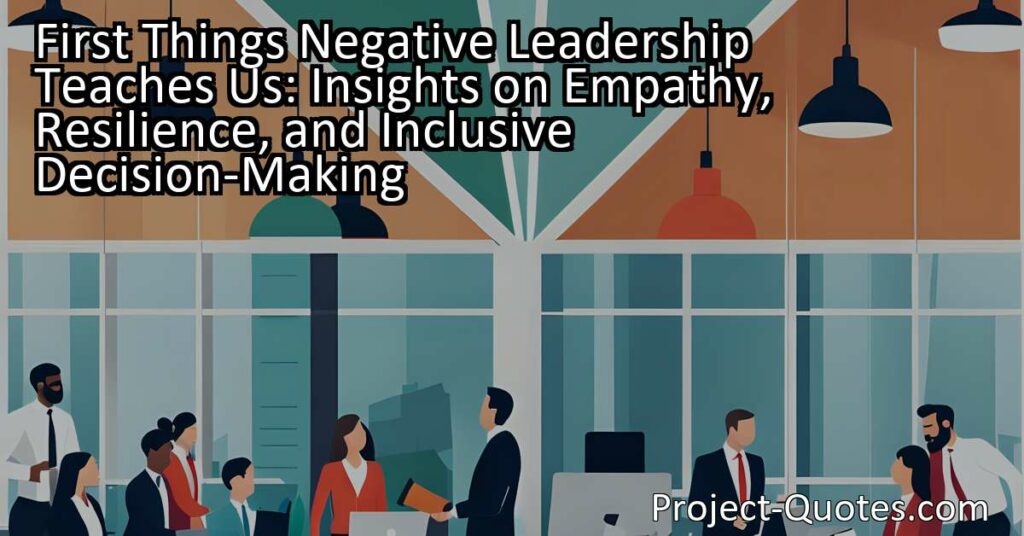You learn far more from negative leadership than from positive leadership. Because you learn how not to do it. And, therefore, you learn how to do it.
Norman Schwarzkopf
First Things Negative Leadership Teaches Us: Insights on Empathy, Resilience, and Inclusive Decision-Making Negative leadership may be unpleasant, but it offers valuable lessons. It teaches us empathy by showing us the impact of harsh criticism. It also highlights the importance of fostering a positive environment, building resilience, promoting inclusive decision-making, and being self-aware, ultimately shaping us into effective leaders.
Table of Contents
- 1 You learn far more from negative leadership than from positive leadership. Because you learn how not to do it. And, therefore, you learn how to do it.
- 2 Norman Schwarzkopf
- 3 Meaning of Quote – You learn far more from negative leadership than from positive leadership. Because you learn how not to do it. And, therefore, you learn how to do it.
- 4 Freely Shareable Quote Image
- 5 Related
Meaning of Quote – You learn far more from negative leadership than from positive leadership. Because you learn how not to do it. And, therefore, you learn how to do it.
Have you ever had a teacher or a coach who was a negative leader? Someone who constantly put you down, criticized your efforts, and made you feel small? It’s not a pleasant experience, is it? However, according to the wise words of General Norman Schwarzkopf, there is value in such negative leadership. He believed that we can learn far more from negative leadership than from positive leadership because it teaches us how not to lead and, in turn, helps us develop effective leadership skills.
Negative leadership can come in various forms, from authoritarian figures who rule with an iron fist to manipulative individuals who use fear and intimidation to control others. Regardless of the specific traits they embody, negative leaders never seem to inspire or motivate those under their authority. Instead, they breed an atmosphere of discontentment, fear, and negativity. So, how can we possibly learn anything valuable from this kind of leadership?
One of the first things negative leadership teaches us is empathy. When we experience firsthand the impact of harsh criticism and belittling remarks, we become more aware of the power our words hold. We learn the importance of treating others with kindness, respect, and understanding. By witnessing the emotional toll of negativity, we gain a crucial insight into the kind of leader we never want to become.
Additionally, negative leadership highlights the significance of fostering a positive and supportive environment. When we are constantly subjected to negativity, we long for a leader who uplifts and encourages us. This longing drives us to create a different kind of atmosphere when we take on leadership roles. We understand the importance of providing constructive feedback, acknowledging others’ efforts, and celebrating their successes. We learn that a positive work environment can do wonders for morale, productivity, and overall team performance.
Another valuable lesson we learn from negative leadership is resilience. Overcoming the challenges posed by negative leaders strengthens our character and equips us with the ability to navigate difficult situations. We develop a determination to persevere in the face of adversity and learn to maintain our composure and professionalism even when faced with hostility. These invaluable skills become building blocks for our future leadership endeavors, empowering us to lead with grace and fortitude.
Furthermore, negative leadership teaches us the importance of inclusive decision-making processes. When leaders exhibit autocratic tendencies, dismissing the thoughts and opinions of others, it becomes painstakingly clear that collaboration and inclusivity are essential for effective leadership. Negative leadership serves as a reminder that true leadership involves valuing and seeking input from all team members, regardless of their status or position. By actively involving others in decision-making processes, we create a sense of ownership, empowerment, and engagement within our teams.
Negative leadership also illustrates the significance of self-awareness. When we encounter leaders whose actions and behaviors we find distasteful, it prompts us to reflect upon our own leadership style. Through this reflection, we gain a deeper understanding of our strengths, weaknesses, and areas for growth. We strive to be conscious of our actions and their impact on others, ensuring that we do not inadvertently become the negative leaders we once despised.
Despite the numerous lessons negative leadership teaches us, it is important to note that positive leadership remains the ideal. Positive leaders inspire, motivate, and empower others to reach their fullest potential. They create an environment where individuals are encouraged to take risks, make mistakes, and learn from them. Positive leadership fosters innovation, creativity, and growth.
Nevertheless, negative leadership should not be disregarded or dismissed outright. It serves as a valuable learning opportunity, shaping us into better leaders ourselves. By experiencing the detrimental effects of negative leadership, we are able to recognize and appreciate the qualities that make positive leadership so impactful.
In conclusion, General Schwarzkopf’s quote encapsulates the idea that we learn far more from negative leadership than from positive leadership. Through encountering negative leaders, we develop empathy, resilience, inclusive decision-making, self-awareness, and an appreciation for positive leadership. While negative leadership is far from ideal, it imparts invaluable lessons that guide and shape us into effective and empathetic leaders. So, the next time you find yourself under the influence of a negative leader, remember that there is always something to be learned from every experience, even the ones we’d rather forget.
I hope this quote inspired image brings you hope and peace. Share it with someone who needs it today!


